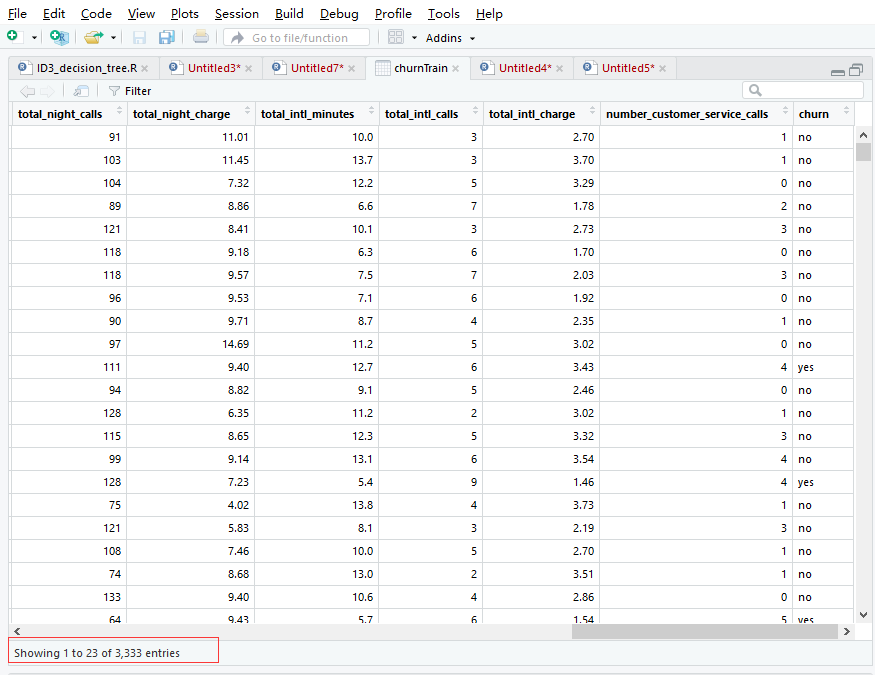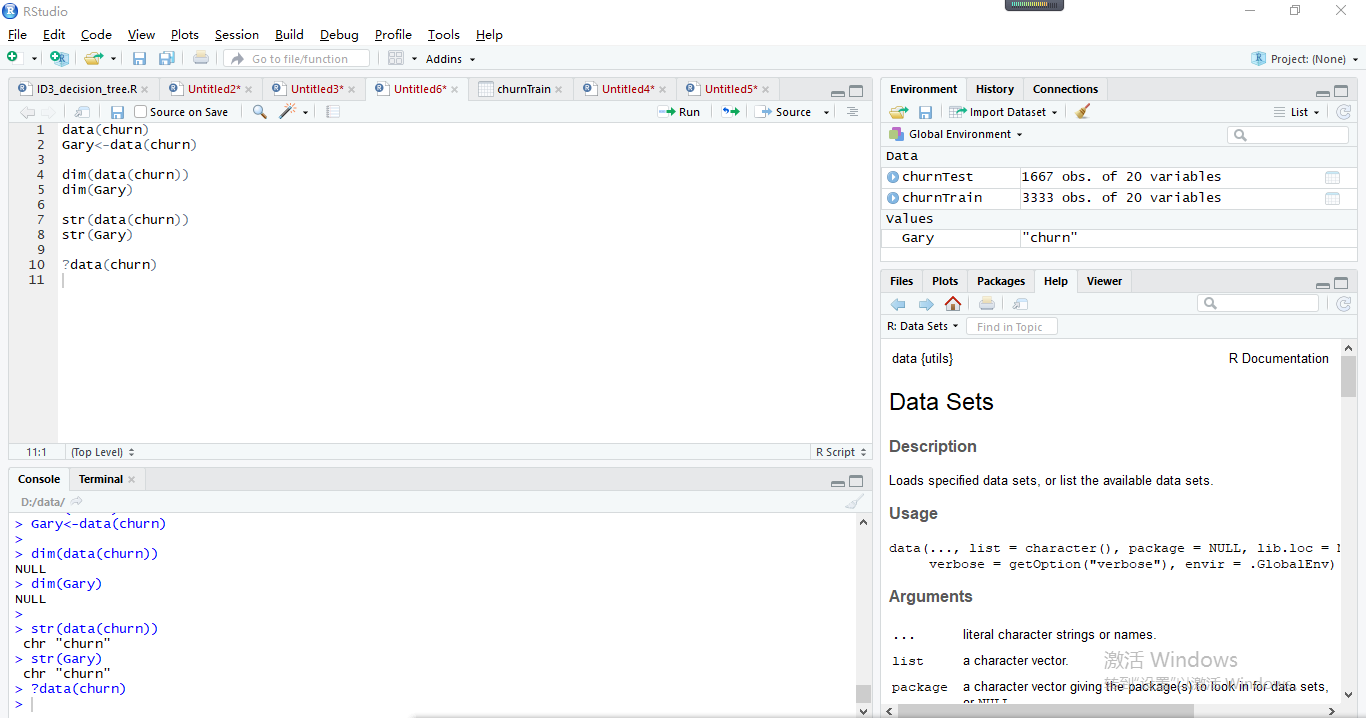R_針對churn資料用id3、cart、C4.5和C5.0建立決策樹模型進行判斷哪種模型更合適
data(churn)匯入自帶的訓練集churnTrain和測試集churnTest
用id3、cart、C4.5和C5.0建立決策樹模型,並用交叉矩陣評估模型,針對churn資料,哪種模型更合適
決策樹模型 ID3/C4.5/CART演算法比較 傳送門
data(churn)為R自帶的訓練集,這個data(chun十分特殊)
先對data(churn)訓練集和測試集進行資料查詢
churnTest資料

奇怪之處,不能儲存它的資料,不能檢視資料的維度 ,不能檢視資料框中每個變數的屬性!!
> data(churn) > Gary<-data(churn) > > dim(data(churn)) NULL > dim(Gary) NULL > > str(data(churn)) chr "churn" > str(Gary) chr "churn"

官方我只看懂了它是一個數據集:載入指定的資料集,或列出可用的資料集(英文文件真是硬傷∑=w=)
用不同決策樹模型去預測它churn資料集,比較一下哪種模型更合適churn資料
比較評估模型(預測)的正確率
#正確率 sum(diag(tab))/sum(tab)
id3建立決策樹模型

#載入資料 data(churn) #隨機抽樣設定種子,種子是為了讓結果具有重複性 set.seed(1) library(rpart) Gary1<-rpart(churn~.,data=churnTrain,method="class", control=rpart.control(minsplit=1),parms=list(split="information")) printcp(Gary1) #交叉矩陣評估模型 pre1<-predict(Gary1,newdata=churnTrain,type='Gary1.Scriptclass') tab<-table(pre1,churnTrain$churn) tab #評估模型(預測)的正確率 sum(diag(tab))/sum(tab)
pre1 yes no yes 360 27 no 123 2823 > sum(diag(tab))/sum(tab) [1] 0.9549955
cart建立決策樹模型

data(churn) set.seed(1) library(rpart) Gary1<-rpart(churn~.,data=churnTrain,method="class", control=rpart.control(minsplit=1),parms=list(split="gini")) printcp(Gary1) #交叉矩陣評估模型 pre1<-predict(Gary1,newdata=churnTrain,type='class') tab<-table(pre1,churnTrain$churn) tab #評估模型(預測)的正確率 sum(diag(tab))/sum(tab)Gary2.Script
pre1 yes no yes 354 35 no 129 2815 > sum(diag(tab))/sum(tab) [1] 0.9507951
C4.5建立決策樹模型

data(churn) library(RWeka) #oldpar=par(mar=c(3,3,1.5,1),mgp=c(1.5,0.5,0),cex=0.3) Gary<-J48(churn~.,data=churnTrain) tab<-table(churnTrain$churn,predict(Gary)) tab #評估模型(預測)的正確率 sum(diag(tab))/sum(tab)Gary3.Script
yes no yes 359 124 no 24 2826 > sum(diag(tab))/sum(tab) [1] 0.9555956
C5.0建立決策樹模型

data(churn) treeModel <- C5.0(x = churnTrain[, -20], y = churnTrain$churn) ruleModel <- C5.0(churn ~ ., data = churnTrain, rules = TRUE) tab<-table(churnTest$churn,predict(ruleModel,churnTest)) tab #評估模型(預測)的正確率 sum(diag(tab))/sum(tab)Gary4.Script
yes no yes 149 75 no 15 1428 > sum(diag(tab))/sum(tab) [1] 0.9460108
實現過程
id3建立決策樹模型:
載入資料,隨機抽樣設定種子,種子是為了讓結果具有重複性
data(churn)
set.seed(1)
使用rpart包建立決策樹模型
> Gary1<-rpart(churn~.,data=churnTrain,method="class", control=rpart.control(minsplit=1),parms=list(split="information")) > printcp(Gary1) Classification tree: rpart(formula = churn ~ ., data = churnTrain, method = "class", parms = list(split = "information"), control = rpart.control(minsplit = 1)) Variables actually used in tree construction: [1] international_plan number_customer_service_calls state [4] total_day_minutes total_eve_minutes total_intl_calls [7] total_intl_minutes voice_mail_plan Root node error: 483/3333 = 0.14491 #根節點錯誤:483/3333=0.14491 n= 3333 CP nsplit rel error xerror xstd #錯誤的XSTD 1 0.089027 0 1.00000 1.00000 0.042076 2 0.084886 1 0.91097 0.95445 0.041265 3 0.078675 2 0.82609 0.90269 0.040304 4 0.052795 4 0.66874 0.72878 0.036736 5 0.022774 7 0.47412 0.51139 0.031310 6 0.017253 9 0.42857 0.49068 0.030719 7 0.012422 12 0.37681 0.46170 0.029865 8 0.010000 17 0.31056 0.43892 0.029171
交叉矩陣評估模型
> pre1<-predict(Gary1,newdata=churnTrain,type='class') > tab<-table(pre1,churnTrain$churn) > tab pre1 yes no yes 360 27 no 123 2823
對角線上的資料實際值和預測值相同,非對角線上的值為預測錯誤的值
評估模型(預測)的正確率
> sum(diag(tab))/sum(tab)
[1] 0.9549955

diag(x = 1, nrow, ncol) diag(x) <- value 解析: x:一個矩陣,向量或一維陣列,或不填寫。 nrow, ncol:可選 行列。 value :對角線的值,可以是一個值或一個向量diag()函式
cart建立決策樹模型:
與id3區別parms=list(split="gini"))
Gary1<-rpart(churn~.,data=churnTrain,method="class", control=rpart.control(minsplit=1),parms=list(split="gini"))
解釋略
> data(churn) > > set.seed(1) > > library(rpart) > > Gary1<-rpart(churn~.,data=churnTrain,method="class", control=rpart.control(minsplit=1),parms=list(split="gini")) > printcp(Gary1) Classification tree: rpart(formula = churn ~ ., data = churnTrain, method = "class", parms = list(split = "gini"), control = rpart.control(minsplit = 1)) Variables actually used in tree construction: [1] international_plan number_customer_service_calls state [4] total_day_minutes total_eve_minutes total_intl_calls [7] total_intl_minutes voice_mail_plan Root node error: 483/3333 = 0.14491 n= 3333 CP nsplit rel error xerror xstd 1 0.089027 0 1.00000 1.00000 0.042076 2 0.084886 1 0.91097 0.96273 0.041414 3 0.078675 2 0.82609 0.90062 0.040265 4 0.052795 4 0.66874 0.72050 0.036551 5 0.023810 7 0.47412 0.49896 0.030957 6 0.017598 9 0.42650 0.53416 0.031942 7 0.014493 12 0.36853 0.51553 0.031426 8 0.010000 14 0.33954 0.48654 0.030599 > > #交叉矩陣評估模型 > pre1<-predict(Gary1,newdata=churnTrain,type='class') > tab<-table(pre1,churnTrain$churn) > tab pre1 yes no yes 354 35 no 129 2815 > > #評估模型(預測)的正確率 > sum(diag(tab))/sum(tab) [1] 0.9507951
C4.5建立決策樹模型:
讀取資料,載入party包
data(churn)
library(RWeka)
使用rpart包J48()建立決策樹模型
> Gary<-J48(churn~.,data=churnTrain) > tab<-table(churnTrain$churn,predict(Gary)) > tab yes no yes 359 124 no 24 2826 > #評估模型(預測)的正確率 > sum(diag(tab))/sum(tab) [1] 0.9555956
C5.0建立決策樹模型:
C5.0演算法則是C4.5演算法的商業版本,較C4.5演算法提高了運算效率,它加入了boosting演算法,使該演算法更加智慧化
解釋略
> data(churn) > treeModel <- C5.0(x = churnTrain[, -20], y = churnTrain$churn) > > ruleModel <- C5.0(churn ~ ., data = churnTrain, rules = TRUE) > > tab<-table(churnTest$churn,predict(ruleModel,churnTest)) > tab yes no yes 149 75 no 15 1428 > #評估模型(預測)的正確率 > sum(diag(tab))/sum(tab) [1] 0.9460108
diag(x = 1, nrow, ncol)
diag(x) <- value
解析:
x:一個矩陣,向量或一維陣列,或不填寫。
nrow, ncol:可選 行列。
value :對角線的值,可以是一個值或一個向量

